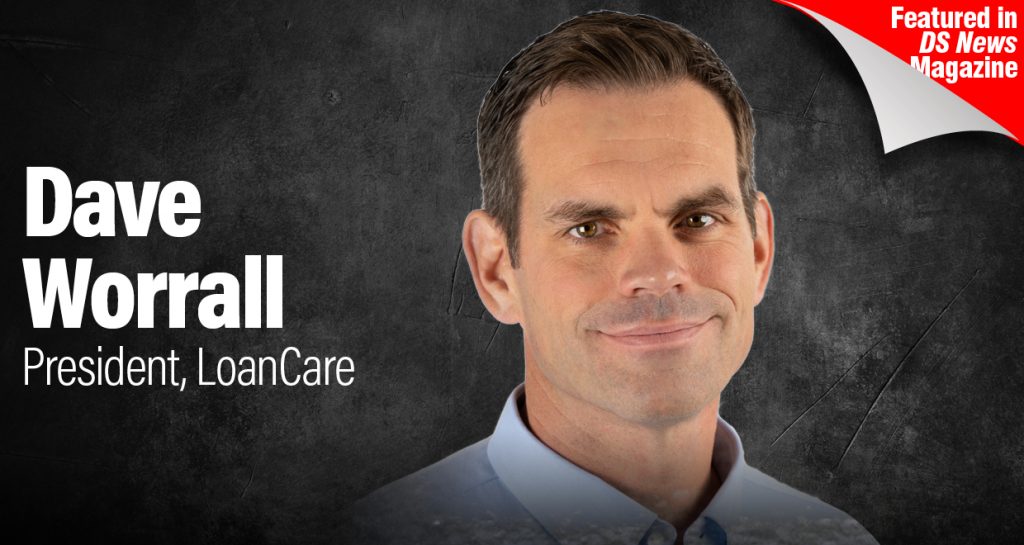
Editor’s note: this piece originally appeared in the June issue of DS News.
Dave Worrall leads a team of seasoned loan servicers to not only add value to their clients’ servicing needs but also help them turn bad situations with borrowers into good ones. Prior to joining LoanCare, Worrall was President of RoundPoint Mortgage Servicing Corporation. He has also held senior leadership roles in loan servicing at Citigroup, Fannie Mae, and GMAC-RFC. While at Fannie Mae, he worked directly with the Department of the Treasury on the Making Home Affordable programs. Worrall earned his Master of Business Administration from Texas A&M University and was a Ford Distinguished Scholar while he attended. He also holds a bachelor’s degree in English from Florida State University. Worrall spoke with DS News on his learnings from his time in the industry during the housing crisis as well as how the servicing landscape has changed over the past decade.
You were VP in the National Servicing Organization at Fannie Mae just as the housing crisis began. How was your experience serving in that role during one of the most chaotic times in our industry?
The experience was both exciting and horrifying. Mortgage servicing became front page news and was suspected as an accomplice for the worldwide financial crisis. The servicing industry was unprepared for mortgage delinquency levels that just years before seemed an impossibility. Fannie Mae’s leadership became a critical factor in delivering assistance to borrowers. It was exciting to be a part of an all-star team passionately committed to helping borrowers and redeeming the reputation of mortgage servicing. It is a comfort that many from this team have grown into leadership roles in the industry and taken with them the lessons learned at Fannie Mae during the crisis.
How have loss mitigation processes changed over the years, especially in the wake of recent natural disasters?
The only way to effectively deal with the rapid escalation of mortgage delinquency during the crisis was through assistance programs. These programs, like the Home Affordable Modification Program, transformed loss mitigation into a functional area that applies a waterfall of solutions to a distressed mortgage. A programmatic approach benefits the industry when natural disasters appear. Disasters usually surprise and these programs give servicers off-the-shelf solutions that they can swiftly apply to relieve the suffering of borrowers affected by events like floods, hurricanes, and fires.
How can servicers cut through language and cultural barriers to effectively serve borrowers?
Web, mobile and virtual assistants solve this problem. These communication platforms give us a limitless opportunity to cheaply build services that meet the needs of every flavor of borrowers. In the next decade, servicers will rush to understand the profiles of the individuals they provide services to and also help them differentiate with customized services and features, which engage borrowers from the start and make working through situations like mortgage delinquency a much easier process.
What are some of the most important industry trends servicers should focus on this year?
Borrowers often think social media is the path of least resistance to address any issue with a servicer. Generally, these platforms do little curation of complaints and therefore often make it difficult for us to effectively address a real problem. Online reputations weigh heavily into a borrower’s trust of a servicer and willingness to cooperate if something goes wrong, so we all need to focus on becoming more sophisticated on social media. The industry also needs more partnership with social media platforms so we can encourage a communications process that always gives servicers a chance to satisfy a borrower.
You have spoken about doing more with less through automation. What kind of innovations are in the pipeline for servicers in the coming years?
Virtual assistants, such as Amazon’s Alexa, will revolutionize servicing in the next decade. Servicers are positioned to benefit from the growing ubiquity of this technology because we have been doing business for years through automated phone systems that force us to continuously refine how we provide service through voice interactions. Virtual assistants allow us to deploy the same functionality to people’s living rooms, mobile phones, and kitchen counters, but with a flexibility that allows us to offer new features that were impossible to think of just a few years ago.
What do you love most about your role at LoanCare and what parallels have you drawn from your previous experiences?
Our sole business at LoanCare is subservicing mortgages. Our job is to add value to our clients’ brands through our service. They depend on us to convert bad situations with borrowers into good ones. This pure purpose makes decisions about our culture, technology, and people easier. I can always test a project, hire, or partner by evaluating how it helps the brands of our clients. In other roles I have held, servicing has been one of many functions that had to compete for attention and resources. That’s just not the case at LoanCare. Servicing is what matters. It comes first.

 DSNews The homepage of the servicing industry
DSNews The homepage of the servicing industry









